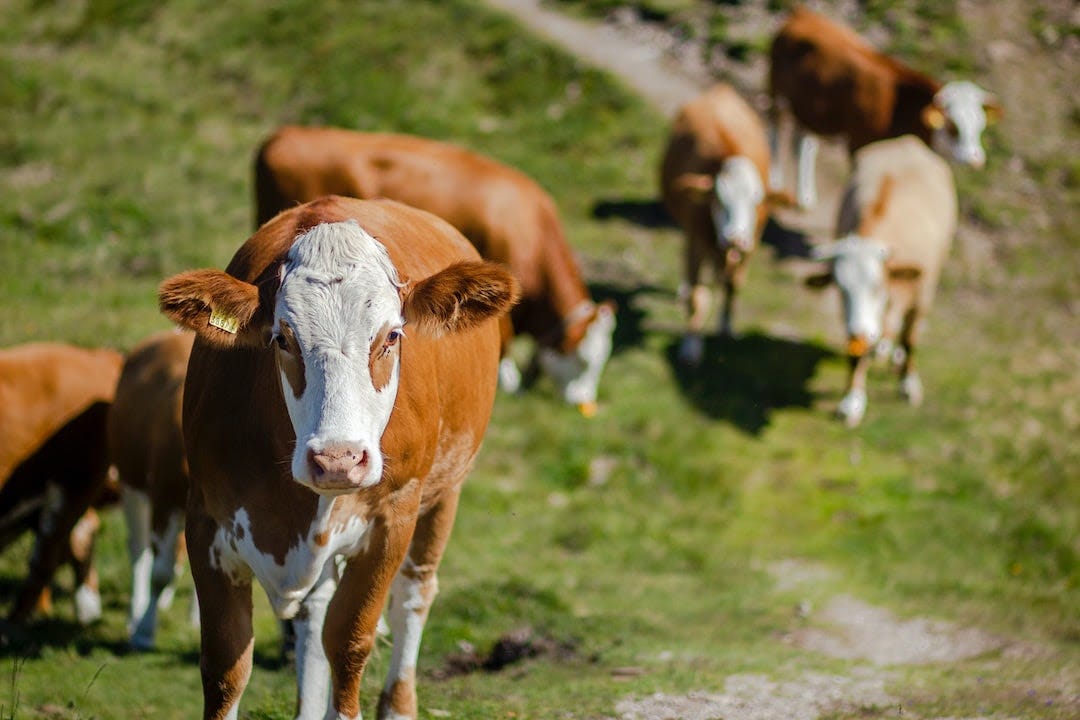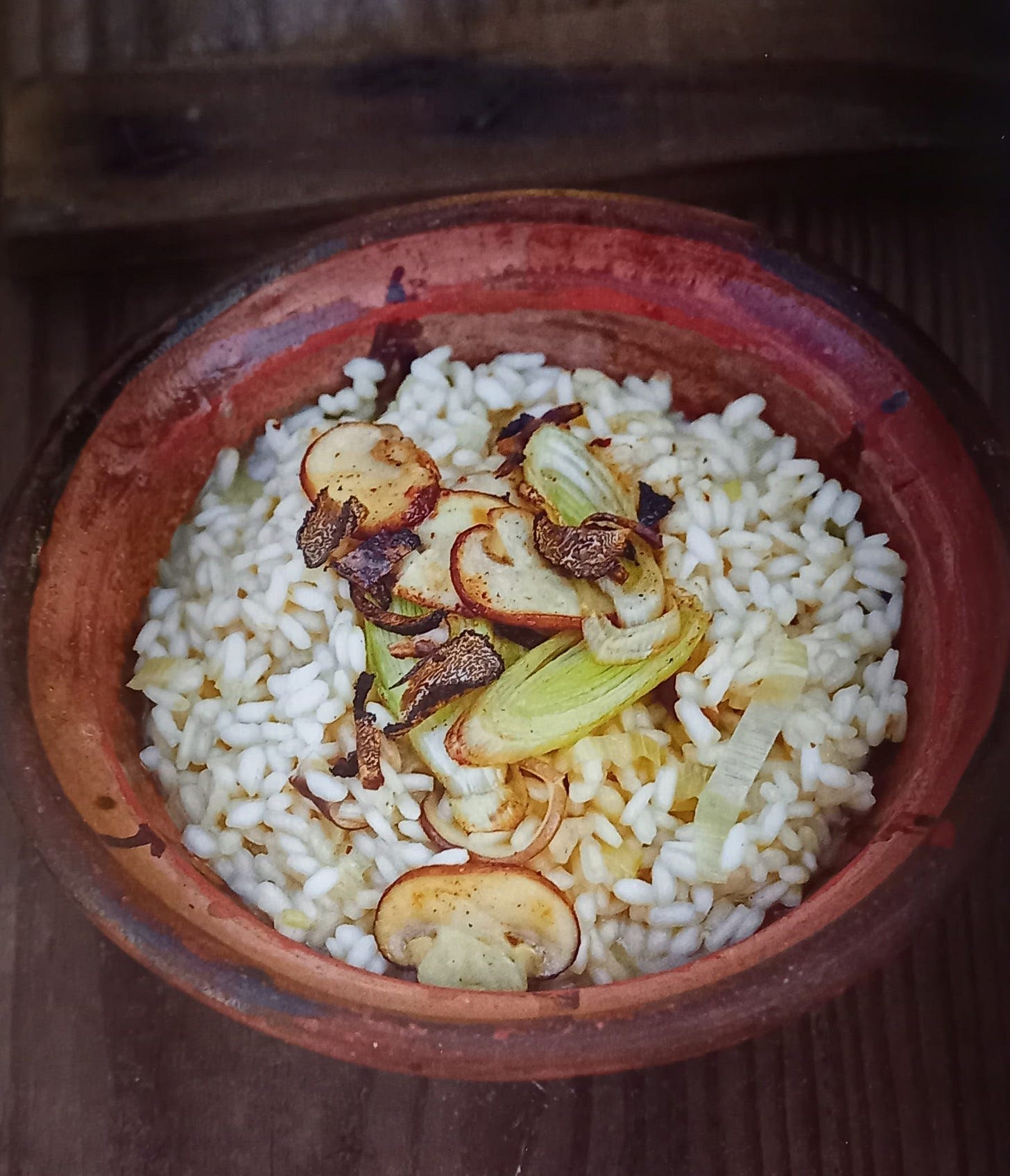Eating from a saucer - the cat and you
A recipe for Truffle, Mushroom and Leek Risotto (Apologies if you are among those who incorrectly were sent this last Wednesday...)

You have four more days to mull over your list of New Year’s Resolutions. The struggle is less in narrowing down what to put on the list than in sticking to it. Those cynics who believe few survive Week One might be pleasantly surprised. At this point, 75 percent of people have stuck to them. After two weeks, the number drops - but only to 71 percent. Even after 6 months, 46 percent are still managing to keep to their resolutions.
So pick them with care.
A completely unscientific poll among those in the room when I thought up carrying this one out revealed fewer health-conscious people were planning to adopt an exercise regime (usually high on the list of resolutions) than were planning to change their diet. Among carnivores, switching animal meat for plant-based alternatives was now up there, as was adopting cultured-meat replacements, as soon as they come to market.
But the cost of meats grown in a laboratory may force the abandoning of that particular resolution pretty fast.
Remember Google co-founder Sergey Brin in 2013, scarfing down, to great media fanfare, the very first hamburger made from meat cells grown in a saucer? As an investor in the project, that fast-food guzzle cost him €250,000, about $331,450. Without a side of fries or a milk shake.
The price has come down, but not very far. Cultured meat, with all its credentials of being slaughter-free, untainted by antibiotics, hormones and disease, could cost around $63 a kilo to produce, as against living meats’ $4-6. So says a recent analysis in the Journal of Agriculture and Food Research.
Seven years after the hoohah surrounding the production of that single Googleburger, Singapore became the first country to sell to fast food diners and supermarkets lab-grown chicken nuggets created from a hybrid of chicken and plant proteins. It provoked a $1.9 billion capital investment from those keen to venture into the field.
Whether lab-based meats or plant-based meats take over, alternatives to conventional meats are now Big Business. And as with any big business, those who have made the initial investment will expect to be handsomely recouped. While it may be they do wish to reduce greenhouse gas emissions, they definitely want to increase the sums they have sunk into the project. So if the public doesn’t bite, no amount of philanthropic thinking is going to keep an enterprise going. Generally, investors tend not to have philanthropic goals high on their short lists of where to put their money.
And the public may not, indeed, bite. Even while considering themselves ethical, health-conscious consumers, and recognising that by 2050 they face a projected global population of 10 billion whose growing middle-class demand for meat will add to its current 15 percent contribution to global greenhouse gas emissions, one third of UK carnivores and over half vegetarians consider lab-grown meat alternatives too disgusting to try.
But once it reaches a viable price-point, unless clarity has been legislated for, honest hoi polloi may not be aware when they’re eating it. The first likely buyers will be fast food outlets who need to keep their prices down.

The only alternative to consuming the meat of animals that have been raised in miserable conditions on feedlots or in crates doesn’t have to be some creation grown in a lab. Buying meat from farmers committed to animal welfare and a life in the open will and should cost you more than buying supermarket bargains. But it will be hormone, dye and additive-free, and keep the guardians of our farmland going and not giving up their farms, which would push our meat supply into the grasping hands of overseas industrial food complexes, and arable land into grasping the hands of developers.
So, whatever resolutions you make for 2023, consider one that protects health: yours, conscientious farmers’, the globe's.
It isn’t necessary to eat meat of any kind to have a splendid meal. Add shavings of truffle to this risotto from wonderful cook Christine Sieger for a musky, meaty flavour and a touch of New Year luxury. Making it with porcini turns it into an even more glamorous dish. If you’re using regular mushrooms, try to find Chestnut not Paris mushrooms. They have more personality.
1 litre/generous 2 US pints chicken or vegetable stock
2 tablespoons olive oil
1 tablespoon butter
2 shallots, peeled and finely chopped
2 garlic cloves, peeled and finely chopped
400g/14 oz risotto rice (Carnaroli, Vialone Nano or Arborio)
2 wine glasses of dry white wine
Salt and freshly ground black pepper to taste
70g/2½ oz butter
2 leeks, white and light green parts only, cut diagonally into thin rings
500g/17¾ oz mushrooms cut into thin slices
Bring the stock to the boil then keep it simmering. In a second pot, heat the olive oil with the butter and the shallots, garlic, leeks and a third of the mushrooms. Sauté them for 15 minutes at low heat until they are soft and translucent. Add the rice and turn the temperature higher, stirring the rice constantly until it looks glossy.
Pour in the wine and continue stirring. Once all the wine has cooked into the rice, add a ladle of hot broth. Reduce the temperature right down so the stock is only just bubbling. Once it has been absorbed by the rice, add another ladle of broth, stirring regularly.
Heat 35g/1¼ oz butter in a pan with 1 tablespoon olive oil and gently fry the rest of the mushrooms. Season to taste.
Add half the fried mushrooms to the risotto and stir, adding a little more broth if necessary, to reach a creamy consistency. The rice grains should be soft but still have some bite. Season to taste with salt and pepper and stir in the remaining butter. Spoon the finished risotto into warmed deep bowls, spread over the remaining fried mushrooms over it and some very thinly shaved slices of trufffle.




On the theme of resolutions, I've been making the same (perfect) resolution for around a decade now -- be more awesome. The beauty is in its flexibility; it's up to you whether more awesome means health, success, adventure, personal growth... Whatever you want to do in 2023, BE MORE AWESOME!